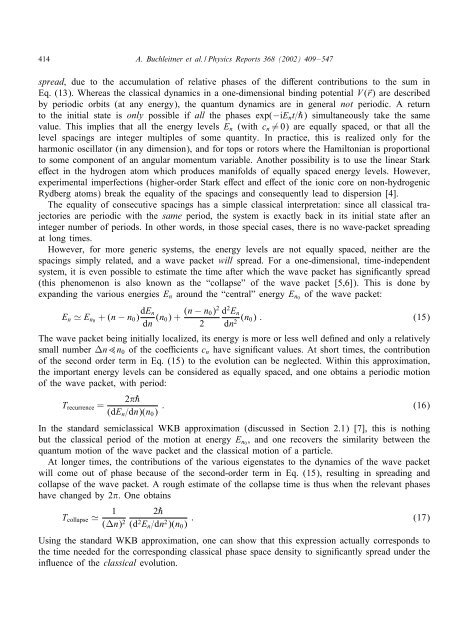Non-dispersive wave packets in periodically driven quantum systems
Non-dispersive wave packets in periodically driven quantum systems
Non-dispersive wave packets in periodically driven quantum systems
Create successful ePaper yourself
Turn your PDF publications into a flip-book with our unique Google optimized e-Paper software.
414 A. Buchleitner et al. / Physics Reports 368 (2002) 409–547<br />
spread, due to the accumulation of relative phases of the di erent contributions to the sum <strong>in</strong><br />
Eq. (13). Whereas the classical dynamics <strong>in</strong> a one-dimensional b<strong>in</strong>d<strong>in</strong>g potential V (˜r) are described<br />
by periodic orbits (at any energy), the <strong>quantum</strong> dynamics are <strong>in</strong> general not periodic. A return<br />
to the <strong>in</strong>itial state is only possible if all the phases exp(−iEnt=˝) simultaneously take the same<br />
value. This implies that all the energy levels En (with cn = 0) are equally spaced, or that all the<br />
level spac<strong>in</strong>gs are <strong>in</strong>teger multiples of some quantity. In practice, this is realized only for the<br />
harmonic oscillator (<strong>in</strong> any dimension), and for tops or rotors where the Hamiltonian is proportional<br />
to some component of an angular momentum variable. Another possibility is to use the l<strong>in</strong>ear Stark<br />
e ect <strong>in</strong> the hydrogen atom which produces manifolds of equally spaced energy levels. However,<br />
experimental imperfections (higher-order Stark e ect and e ect of the ionic core on non-hydrogenic<br />
Rydberg atoms) break the equality of the spac<strong>in</strong>gs and consequently lead to dispersion [4].<br />
The equality of consecutive spac<strong>in</strong>gs has a simple classical <strong>in</strong>terpretation: s<strong>in</strong>ce all classical trajectories<br />
are periodic with the same period, the system is exactly back <strong>in</strong> its <strong>in</strong>itial state after an<br />
<strong>in</strong>teger number of periods. In other words, <strong>in</strong> those special cases, there is no <strong>wave</strong>-packet spread<strong>in</strong>g<br />
at long times.<br />
However, for more generic <strong>systems</strong>, the energy levels are not equally spaced, neither are the<br />
spac<strong>in</strong>gs simply related, and a <strong>wave</strong> packet will spread. For a one-dimensional, time-<strong>in</strong>dependent<br />
system, it is even possible to estimate the time after which the <strong>wave</strong> packet has signi cantly spread<br />
(this phenomenon is also known as the “collapse” of the <strong>wave</strong> packet [5,6]). This is done by<br />
expand<strong>in</strong>g the various energies En around the “central” energy En0 of the <strong>wave</strong> packet:<br />
En En0 +(n− n0) dEn<br />
2 (n − n0) d<br />
(n0)+<br />
dn 2<br />
2En dn2 (n0) : (15)<br />
The <strong>wave</strong> packet be<strong>in</strong>g <strong>in</strong>itially localized, its energy is more or less well de ned and only a relatively<br />
small number nn0 of the coe cients cn have signi cant values. At short times, the contribution<br />
of the second order term <strong>in</strong> Eq. (15) to the evolution can be neglected. With<strong>in</strong> this approximation,<br />
the important energy levels can be considered as equally spaced, and one obta<strong>in</strong>s a periodic motion<br />
of the <strong>wave</strong> packet, with period:<br />
2 ˝<br />
Trecurrence =<br />
: (16)<br />
(dEn=dn)(n0)<br />
In the standard semiclassical WKB approximation (discussed <strong>in</strong> Section 2.1) [7], this is noth<strong>in</strong>g<br />
but the classical period of the motion at energy En0, and one recovers the similarity between the<br />
<strong>quantum</strong> motion of the <strong>wave</strong> packet and the classical motion of a particle.<br />
At longer times, the contributions of the various eigenstates to the dynamics of the <strong>wave</strong> packet<br />
will come out of phase because of the second-order term <strong>in</strong> Eq. (15), result<strong>in</strong>g <strong>in</strong> spread<strong>in</strong>g and<br />
collapse of the <strong>wave</strong> packet. A rough estimate of the collapse time is thus when the relevant phases<br />
have changed by 2 . One obta<strong>in</strong>s<br />
Tcollapse 1<br />
( n) 2<br />
2˝<br />
(d 2 En=dn 2 )(n0)<br />
: (17)<br />
Us<strong>in</strong>g the standard WKB approximation, one can show that this expression actually corresponds to<br />
the time needed for the correspond<strong>in</strong>g classical phase space density to signi cantly spread under the<br />
<strong>in</strong> uence of the classical evolution.











